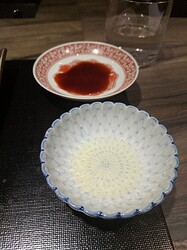Special dinner at Shoji last night. Chef Derek Wilcox hosted Kenya Sakai, who designed and, with Chef Wilcox, implemented a wonderful mid-Spring kaiseki meal using mostly imported Japanese ingredients. They previously worked together at Kikunoi. Course titles are my best guesses based on what little I know about kaiseki. Course descriptions are from a printed menu, augmented with what I learned from the chefs during the meal. Photos by me. If you want to see much better ones, go lurk on Instagram, where more talented food photographers hawk their wares.
Sakizuke (先附): appetizer
Hotaru ika (firefly squid), angelica and fiddle head ferns with chopped kinome (sansho leaf) and kinome jelly. Angelica is called tara no me in Japanese and fiddleheads are either warabi, zenmai or kogomi. But since these were all foraged locally, let’s call them by their english names. These squid are at their peak right now, chunk full of guts. The flavors of kinome were a great contrast.
Hassun (八寸): the second course, which sets the seasonal theme.
Clockwise from top: Tomato enveloped in a clam tosazu (vinegar dressing), aburaage (fried strips of tofu) & spinach, roe-bearing iidako (baby or just small? octopus), smoked mackeral summer roll, grilled beans marinated in saikyo miso. The octopus with roe tasted like a the firefly squid but with the flavor increased by several orders of magnitude.
Mukōzuke (向付): a sliced dish of seasonal sashimi.
Tai (red sea bream), katsuo (skipjack tuna), sumi-ika (squid), kinmedai (golden eye snapper) and chutoro from Iwate. The katsuo was topped with ponzu, the other fish could be dipped into either tosa soy sauce or a sansho oil with sea salt.
Maine uni served over rice with nori, daikon and chives.
bonus mukōzuke? another name for this course? dunno…
Futamono (蓋物): a “lidded dish”; typically a soup.
Takenoko (bamboo shoots) from Kagoshima, wakame and kinome.
Tasted like corn! Dashi game is strong.
Yakimono (焼物): a grilled dish
Amadai (tilefish) grilled with its scales, nanohana (rapeseed, like broccoli rabe), dehydrated hatcho miso and a sesame dressing.
Nimono (煮物): a simmered dish
Poached awabi (abalone), mushrooms, kuwai (arrowhead bulb), shungiku (chrysanthemum) and ginger in a thickened dashi.
Naka-choko (中猪口): a palate-cleanser; often a light, acidic soup
Asparagus udon, nasturtium leaf and flower, myoga and shrimp oil. I’m guessing again on the name of this course; it was very paradoxically packed with flavor but light and refreshing. The dashi was very smokey and united the asparagus and shrimp oil. People were asking for seconds.
Shiizakana (強肴): a substantial dish.
Grilled Omi-gyu beef tenderloin, soy sauce-preserved sansho berries, winter truffle-potato puree, spring salad with yuzu dressing.
Gohan (御飯): a rice dish made with seasonal ingredients. x2!!!
Sakura ebi, gobo and onion, fried
Anago and green onion “oyakodon” - eel ‘n’ egg?
Kō no mono (香の物): seasonal pickled vegetables.
Daikon, radish, napa cabbage and kombu. All made in house by Sakai-san during his weeks in NY leading up to this dinner.
Tome-wan (止椀): a miso-based or vegetable soup***
This was aka (red) miso soup, sorry no photo.
Mizumono (水物): a seasonal dessert
Fresh strawberries, strawberry-champagne granita, strawberry jelly and confit with mint and orange blossoms.
Chilled apricot kernal “tofu”. Ugly(?) but seriously delicious. Wow.
I was expecting mostly an almond-like flavor, like what you get from peach pits. This had a little of that, but also a very delicate apricot flavor.
Does this portend a shift from sushi/kappo to more formal kaiseki at Shoji? While this meal was fantastic, I love Derek’s sushi so much, I hope this was the kick-off to special events, rather than a harbinger of a major change in direction. Congratulations to Sakai-san, for pulling off an amazing meal and who literally just days ago became a father!
Postscript: certain people might be curious what was drunk…
-
Amabuki Omachi Kimoto Junmai Daiginjo - good to start, but I drank too slow, it warmed up and I’m wasn’t so enamored with its profile at room temp.
-
Tedorigawa “Kinka” Nama Daiginjo - this was very easy to like, thought it paired well with the tilefish, abalone and udon.
-
Mimurosugi Junmai Daiginjo - glad to have tried it, wished I had a junmai or something bolder for the beef and donburi dishes.













































